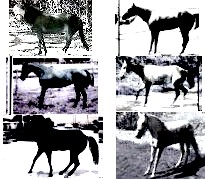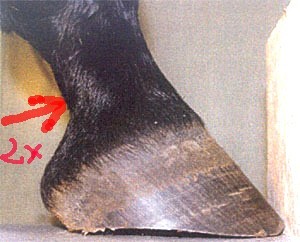DID YOU SAY "FOUNDER"?
by Carola Adolf, NEP/fSHP
There is a lot to say about laminitis (the inflammation of the laminae) and founder, what causes it, and how to prevent and treat it.
Generally speaking: Laminitis is the acute inflammation of the laminae tissue of the hoof as the result of a metabolic (systemic) problem in addition to a mechanical problem in an already weakened part of the hoof. It may result in "founder" aka "the separation and rotation of the coffin bone" .
The hoof (rather "the corium") is a metabolic organ - it excretes excess proteins in form of horn. The corium is a highly vascular, spongelike structure that surrounds the coffin bone (also read The Hoof & It's Function ) - it is a structure that has evolved from what we know as "periosteum").
If its healthy function is compromised for whatever reason (e.g. not enough hoofmechanism for good circulation, not enough movement, incorrect hoofshape, shoeing....) then it is susceptible to damage as soon as the system is challenged by TRIGGERS like:
* Excess feed intake generally.... (* too much sugars can create glucose intolerance)
* Medication.....
* Hormonal changes.....
* Poisoning....
* Local trauma (e.g. "road founder")
If there is already a susceptibility (through weakness, stress... ) within this tissue AND one of these above triggers occur, then there will be localised inflammation with all related symptoms.
Inflammation is the bodies' natural reaction to injury and/or abnormal stimulation caused by a physical, chemical or biological agent. It can include heat, redness, swelling and pain due to the underlying efforts to remove agents causing the damage and to begin the repair and healing process.
Since there is no room for swelling within the hoofcapsule (and wound secretion), a "breakdown" at a cellular level will eventually occur and tissues start to separate.....
The coffin bone loses its suspension as the laminar connection starts to break down and separate - and rotation may occur.
(Note: Sometimes there is no rotation, but "only" separation... e.g. when the hoofcapsule is fixed through shoeing/frog support etc. HOWEVER: This may result in a dropped coffin bone - a "sinker", as soon as the brace or the "support" is removed...)
The separation, as well as the rotation process is immensely painful (plus the pressure from the swelling itself), as the weight of the body comes down through the bone column of the leg onto the coffin bone and tears the suspending and stressed laminar connection apart.
This process can happen almost un-noticed and a little at a time - over a long period of time, but it can also happen within hours!
If the coffin bone is already sitting too steep within the hoofcapsule (e.g. because the heel is too high), then it usually goes for a "nose dive", putting extra pressure onto the circumflex artery that supplies circulation to (amongst other parts of the hoof) the solar corium.
What can be done?
* Recognizing trouble:
If you notice that your horse/pony is not as mobile and active as usual ("slightly off colour"), don't ignore the warning signs!
Go and check his/her hooves and feel for
A) HEAT
B) DIGITAL PULSE >>>>>>>>>
also (C) HARD NECK CREST)
Don't wait to find your horse in agony and standing in the "founder stance", as (s)he tries to take the weight of the painful front feet (the weightbearing feet)
FIRST AID
PLEASE NOTE!
IT IS IMPORTANT THAT YOU TAKE ACTION WITHIN THE FIRST 24-48 HOURS AFTER ONSET OF ACUTE SYMPTOMS
Do NOT delay: Get help of your veterinary surgeon and a knowledgeable hoofcare provider!!!
* Identify the "trigger" and remove it (e.g. if you have a pony on lush spring grass, re-locate pony immediately)
* Apply "crytotherapy" (cooling/ice therapy) to arrest the inflammation and swelling (woundsecretion) without suppressing the bloodcirculation.
(Stand the affected hooves in buckets and cover with iced water for 15-20 minute periods with rest periods in between. This will reduce the "heat", and damaging swelling of laminar tissue in the hoofcapsule)
* Call your veterinarian and hoofcare provider:
* Your veterinarian will be able to help with the acute pain relief and will provide radiographs if necessary, especially if rotation of the coffin
bone is suspected. (Be aware that anti inflammatory drugs slow down the healing process).
* Your hoofcare provider must correct hoof form asap, so coffin bone is placed in a ground-parallel position
and stress is taken from the dorsal part of the laminae!!!
* Do NOT! lock the horse up in a stable but encourage the horse to move (hand walk if possible) as soon as possible
(but NOT before the acute phase has subsided!) Every step counts,because "hoofmechanism" means effective circulation, so healing can take
place.
Allow the horse to chose the tempo it is comfortable with (encourage - don't force!) and walk him/her on level, firm but non-concussive ground.
(Avoid deep sand, as the toe will sink down into it, therefore creating a high heel/low toe alignment - which you need to avoid!).
* Do not starve the horse/pony. Allow him/her grass hay at lib. (If necessary, soak to flush out excess sugars! See www.safergrass.org
Consult knowledgeable herbalist for advise on
* metabolic support (detox, liver/ kidney tonic, aids to improve acid/alkaline balance)
* natural pain relief if required
REHABILITATION:
Hoofcare & Trimming:
* Trim hoof to achieve ground parallel coffin bone (DE-ROTATE)
(have x-rays taken so your hoofcare provider knows how much (s)he has to trim to compensate for any existing rotation.
Rotation can also be determined to a degree by visual evidence e.g. angle of hairline, bone alignment - but radiographs are better!)
* Relieve any tension/forces on dorsal wall (toe) by backing it (to white line or if necessary further). Please seek help of
knowledgeable hoofcare provider!)
* Trim (touch-ups) often (as required)...) because heels and bars may grow fast (* Your hoofcare provider should be willing to show you how to
make touch-ups in between his/her visits yourself, so the situation can be "stabilised" for the best possible outcome: Healing)
* Keep hooves elastic (soak daily in water)
Other
* Encourage (do not force!) movement - "feed here, water there" (horse/pony will move at the pace that it can cope with.best... yes it will get better.....!)
BUT WITHOUT MOVEMENT, NO IMPROVEMENT!
Go for walks when acute phase is over, and attach boots (e.g. Old Macs, Cavallo), with inlays if necessary in case of a convexing sole.
* Seek advise from Herbalists and/or Homeopath for
- pain management
- metabolic support (strengthening metabolic organs like kidneys and liver, detox, re-establishing acid/alkaline balance))
- assist circulatory system
- muscle relaxation (horses in pain most likely suffer sore, tense muscles)
* Book sessions for other supportive/holistic treatments to help your horse's system to heal and recuperate faster.
(e.g Massage, Bowen and other energy and/or other tactile therapies, like Photonic stimulation).
* Control diet and be aware of other "metabolic challenges".
* Allow natural lifestyle for optimal physical and psychological health
If there is no damage to the coffin bone itself (which often happens in chronic founder cases or horses that had to live in "fashionable high stiletto heels"), your horse/pony can regrow a new and normal hoofcapsule (and connection/suspension) within 10-12 months.
There may be abscessing to clear out necrotic tissue. This is part of the healing process.
Tip: Watch horses and ponies when they reach the age of maturity. 3-6 y.o.. Their metabolism slows down and "triggers" may effect their system easily, especially when there is some damage to the the delicate tissue in the hoof, due to pathological hoof form,lack of blood flow, or lack of movement or other lifestyle problems.
Once they had a systemic (metabolic) problem which resulted in founder, they need careful management for the rest of their life.
REMEMBER: PREVENTION IS BETTER THAN CURE!
LAMINITIS AND FOUNDER IS PAINFUL BUT IT IS NOT A DEATH SENTENCE IF YOU AS OWNER TAKE RESPONSIBILITY FOR THE HEALTH OR RECUPERATION OF YOUR HORSE/PONY BY GETTING INVOLVED AND DO WHAT IS REQUIRED.
Seek help of those who want to heal and cure and have the knowledge to help you help your horse.
If your horse/pony is affected by laminitis, founder, please visit this link as well:
(Gretchen Fathauer's fantastic and huge website on laminitis/founder..... essential reading, if you have a laminitis/founder patient!
Good Luck .....
and don't give up on your laminitis/founder horse/pony.
There IS help!
Please don't hesitate to contact me for a first, second or third opinion!
Your horse/pony is worth it!



